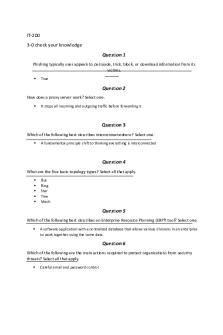A&P 1 Exercise 4 Reviewing Your knowledge & Using Your Knowledge PDF

| Title | A&P 1 Exercise 4 Reviewing Your knowledge & Using Your Knowledge |
|---|---|
| Author | VV Vv |
| Course | Anatomy & Physiology I With Lab |
| Institution | Chamberlain University |
| Pages | 3 |
| File Size | 159.7 KB |
| File Type | |
| Total Downloads | 38 |
| Total Views | 172 |
Summary
Lab worksheet...
Description
Reviewing Your Knowledge
4
A. Cellular Structure Fill in the blank with the name of the cell structure that fits the description.
Cilia 1. short, hair-like projections for movement of substances along cell surface Cytosol 2. intracellular fluid Mitochondria 3. site of energy production by cellular respiration Ribosomes 4. site of protein synthesis Smooth ER 5.site of steroid and fatty acid synthesis Lysosomes 6. small vesicle with digestive enzymes Centrosomes 7. organelles needed to form cilia and flagella Chromatin 8. thread-like strand of DNA with associated proteins Rough ER 9. site of secretory and membrane protein synthesis Golgi Apparatus 10. site where protein products are stored, packaged, and exported Nucleus 11.contains DNA that control cellular activities Nucleolus 12.site of ribosome synthesis Cytoskeleton 13.gives the cell shape, support, movement, and holds organelles in position Plasma Membrane 14. controls movement of substances into or out of the cell Microvilli 15. folds of the plasma membrane that increase the cell's surface area Peroxisomes 16.detoxifies harmful substances, produces hydrogen peroxide, and oxidizes amino acids Nuclear membrane 17.double membrane that separates the nucleus from the cytoplasm Secretory vesicles 18.a small membranous sac that delivers proteins to the plasma membrane to exit the cell
B. Phases of the Cell Cycle Write the phase of the cell cycle that the phrase describes. Cytokinesis 1.cytoplasmic division Interphase 2.cell performing normal functions; longest phase Mitosis 3.nuclear division Metaphase 4.chromatid pairs line up at equatorial plate Prophase 5.chromatin condenses into chromosomes Telophase 6.spindle fibers break up; nucleus reappears Anaphase 7.centromeres divide; chromosomes move to opposite poles Prophase 8.nuclear membrane disassembles and disappears Telophase 9.chromosomes unravel to form chromatin Prophase 10.mitotic spindle forms Interphase (S phase) 11.DNA replicates
EXERCISE
Using Your Knowledge A. Cellular Organelles and Their Function
4
Write the letter for the correct answer in the blank. _____b____ 1.A cell makes and secretes a protein-based hormone. This particular cell would have a great amount of RER and: (a)SER (b)Golgi complex (c)mitochondria (d)lysosomes _____a_____ 2.Testes and ovaries that make steroids (lipids) would have a larger amount of: (a)SER (b)RER (c)mitochondria (d)lysosomes _____d_____ 3.Muscle cells that need large amounts of ATP would have many: (a)Golgi complexes (b)ribosomes (c)SER (d)mitochondria _____d____ 4.Cells that line the small intestine are specialized for absorption and secretion. The plasma membrane structure they have to accomplish this is: (a)centrioles (b)cilia (c)flagella (d)microvilli _____c____ 5.Immune cells that destroy bacteria with chemicals need an abundance of: (a)SER (b)ribosomes (c)lysosomes (d)centrioles
B. The Cell Cycle and Mitosis Answer each question with a short answer. 6.Explain the role of somatic cell division as a person ages from infancy to adulthood. From infancy, millions of new cells produce each minute but there is a time where they don’t divide anymore and are in the G0 phase. Other cells have a limited capability of dividing. The process of dividing slows down as one ages and that is why as adults we stop growing. Cessation of mitosis is a normal genetic programmed event. 7.Explain the role of cell division in wound healing. Skin cells replicate themselves through mitosis in order to create new skin cells to replace the damaged cells and skin to cover the wound. 8.List the cell structures involved in mitosis. Nucleus, centrioles, plasma membrane 9.Can red blood cells undergo mitosis? Explain. Red blood cells cannot undergo mitosis because mitosis is a nuclear division process and Red blood cells don’t have a nucleus. 10.Sperm and eggs have one-half the number of chromosomes of the somatic cells that divided to form them. Are sperm and eggs formed by mitosis? Explain. Sperm and egg are not formed by mitosis because in Mitosis each cell gets the same number of chromosomes as the original cell. The sperm and egg need to go through a reproductive cell division which only occurs in Meiosis. 11–14. Name four cellular organelles that are membrane bound. 11. mitochondria 12. Nucleus 13. Golgi Apparatus 14. Endoplasmic Reticulum 15–17. Which cellular organelles are not membrane bound? 15. cilia & Flagella 16. Ribosomes 17. Cytoskeleton 18–20. Identify the three structures indicated in Figure 4.5 18. Smooth Endoplasmic Reticulum 19. Rough Endoplasmic Reticulum 20. Ribosomes...
Similar Free PDFs

Reviewing your Knowledge Anatomy
- 4 Pages

Exercise 27 Use Your Knowledge
- 2 Pages

Knowledge Management
- 30 Pages

Using Quotes in Your Writing
- 2 Pages
Popular Institutions
- Tinajero National High School - Annex
- Politeknik Caltex Riau
- Yokohama City University
- SGT University
- University of Al-Qadisiyah
- Divine Word College of Vigan
- Techniek College Rotterdam
- Universidade de Santiago
- Universiti Teknologi MARA Cawangan Johor Kampus Pasir Gudang
- Poltekkes Kemenkes Yogyakarta
- Baguio City National High School
- Colegio san marcos
- preparatoria uno
- Centro de Bachillerato Tecnológico Industrial y de Servicios No. 107
- Dalian Maritime University
- Quang Trung Secondary School
- Colegio Tecnológico en Informática
- Corporación Regional de Educación Superior
- Grupo CEDVA
- Dar Al Uloom University
- Centro de Estudios Preuniversitarios de la Universidad Nacional de Ingeniería
- 上智大学
- Aakash International School, Nuna Majara
- San Felipe Neri Catholic School
- Kang Chiao International School - New Taipei City
- Misamis Occidental National High School
- Institución Educativa Escuela Normal Juan Ladrilleros
- Kolehiyo ng Pantukan
- Batanes State College
- Instituto Continental
- Sekolah Menengah Kejuruan Kesehatan Kaltara (Tarakan)
- Colegio de La Inmaculada Concepcion - Cebu











